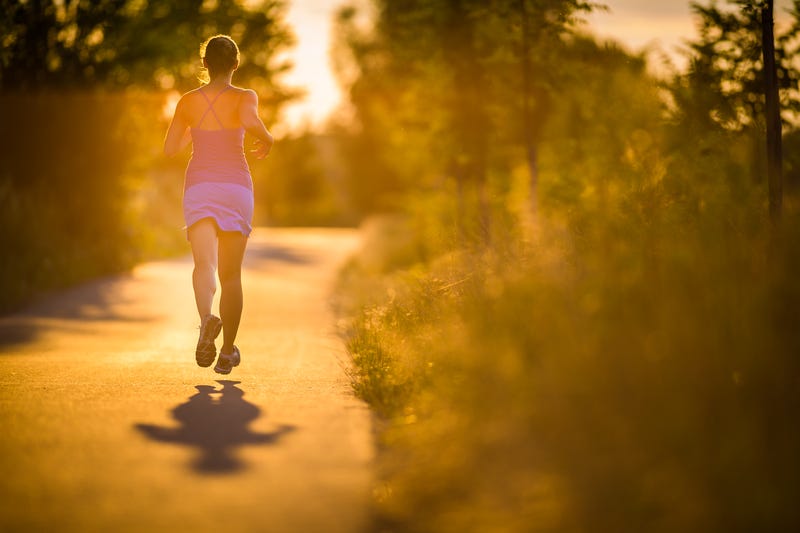When I switched up the schedule recently for the days I publish newsletters, my goal was for our Monday issue to help us kick off the week, gathering what we’ve learned from the week just passed and sharing some inspiration for the week ahead.
But, as often happens, life intervened in the form of a sweltering heat wave that’s enveloped much of the U.S. over the past few weeks. I don’t know about you and where you live, but OHWOW has it been hot here where I live in Atlanta and (usually) run outdoors, along the Chattahoochee River that runs through the city.
This weekend, I went there to run six miles on Saturday, so I could get in my long run as part of the training schedule we’re following for November’s Richmond Half. When I looked at my phone’s weather app, I saw it was 78 degrees and figured it would be no problem; just a couple of weeks ago, I’d run three days in a row outdoors with temperatures close to 90.
But around the time I finished mile three, I could feel myself tiring out quickly, a lot more quickly than I expected. In the past, I’ve done run-walk-run training, so I let myself walk for a bit, telling myself I’d run again in no more than 60 seconds. And, I was able to do that — but, by the time I finished my fourth mile, I felt completely wiped out.
That’s when I thought popped in my head about a recent article I’d stumbled across on dew points, which led with this observation: “When a 72-degree day feels like a swampy armpit, I start to realize that everything I’ve ever thought I understood about weather, mainly temperature, is a lie.”
Maybe, just maybe, I realized, the 78 degrees I thought I was running in aren’t quite what the temperature alone indicated. (A fact I’d confirm when I got back to my car and checked my phone again, which indicated the dew point was 74.)
In the days leading up to this weekend, a pair of torrential thunderstorms had swept through Atlanta, leaving our air at a dew point in the mid-70s — or, what the air feels like closer to a tropical latitude than where I live, and could even be classified as “oppressive.”
The entire article — which really is an extended interview with meteorologist John Homenuk — is worth reading, but these two paragraphs capture its essence and point to why paying attention to dew points is essential to having a good running experience outdoors, at least until cooler weather arrives:
“Thankfully, I’ve found a better number to tell me how it’s going to feel outside — and it’s not the relative humidity, which is also a sham. It’s the dew point.
The lower it is — ideally in the 50s to 60s — the less sticky it will feel. The higher it is (70s) the closer it will be to my personal hell. (The relative humidity, a sometimes popular metric, measures the dew point against the temperature, making it particularly unhelpful on very, very hot days, when the temperature may be much higher than a relatively low, but still uncomfortable, dew point.)”
Years ago, I worked as a writer for The Weather Channel’s weather.com, so you might think I would know a lot about the weather and pay close attention to it today; I wish that were the case! Once again, I’ve learned that if you don’t stay up-to-date on something, even a knowledge area you’ve studied and think you know well, it’s easy to get over-confident and believe you know more than you really do.
So, for at least the next two to three weeks, I’ll primarily run on my treadmill — not the ideal, I know; as Vybarr Cregan-Reid wrote in his 2016 book Footnotes, “Time spent on a treadmill is lost to me. I can rarely remember treadmill runs, just that I’ve done them” — though I hope to get back outdoors as soon as I can.
What’s it like where you’re running? Are you able to get outside to run and enjoy it right now, even though it’s mid-August?
As always, keep in touch and let me know how your running/life is going — especially if you’re following our training and plan to meet up with us this November.
Your friend,
— Terrell
Our training miles for this week
How did your six-mile long run go this weekend? If it’s the first run of that length you’ve done in a long time, I imagine it was a stretch — and that you enjoyed some well-deserved rest afterwards! We’ll run it again this weekend, to solidify our confidence in that distance — you’ve already done it, so you know you can do it, right?
Tuesday, Aug. 15 — 4 miles
Thursday, Aug. 17 — 4 miles
Saturday, Aug. 19 — 6 miles
Sunday, Aug. 20 — 3 miles
As always, feel free to reach out with any questions about our schedule, your running, or anything else 👍 — Terrell




Quick funny story. Ran a two man relay race this weekend and race coordinator found me a partner. The way they did age group awards was total of two ages divided. My partner regularly wins half marathons outright at 31 years old. So I now have a first place trophy in the 46- 50 year old male. Only took me 20 years to get one. Our age total 100.
Accumulating to humidity running has it’s beneficial side. The main issue with humidity is that the body has a harder time cooling itself if sweat won’t evaporate. Slow down run by perceived effort not time. Visor or no hat, frequent breaks and in the shade as much as possible. Fluffy hair scrunchies dampened and overnight in freezer, worn on the wrist ( it works) cooling towel on neck. No caffeine, no gels lots of water or no sugar electrolyte drinks. If the temperature is not too hot run later. Humidity is worst in the morning. On the benefit side the body will produce more blood to assist in both cooling and oxygen to the muscles. Train this way and when you run that cool November morning you can fly.